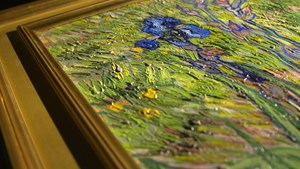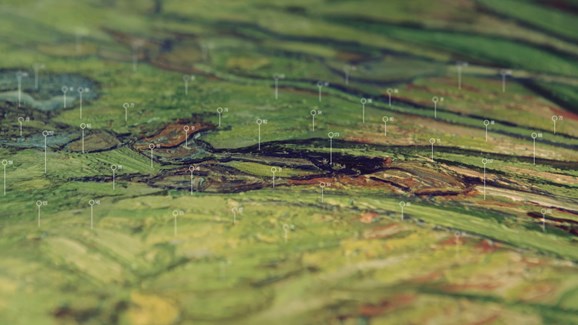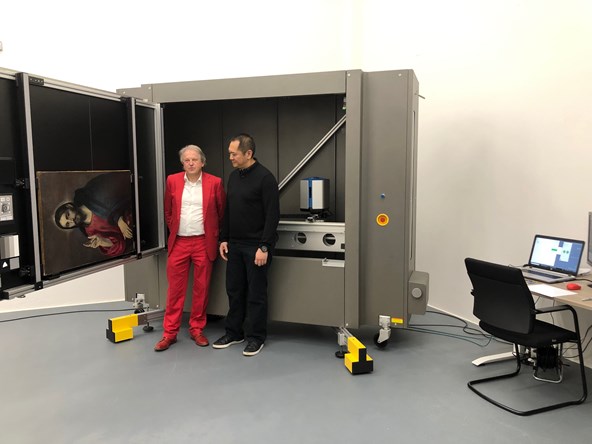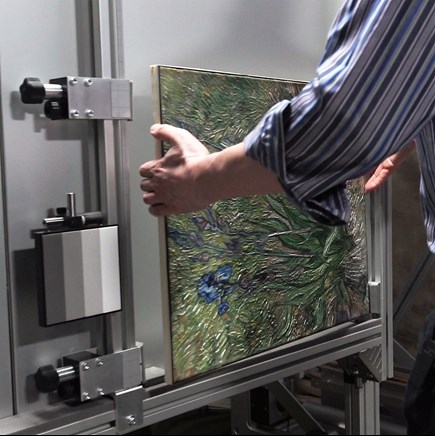
A conversation explores how Arius’ cutting-edge art technology has broad implications in the art world; from aiding provenance and art authentication to the introduction of a new fine art print process that merges analog and digital processes.
Image: Van Gogh "Iris" Print and Frame, copyright Arius Technology
ArtDependence, Etienne Verbist (AD): Who are you and WHY do you do what you do?
Paul Lindahl, Co-Founder and CEO of Arius (PL): Arius is a leading art technology company that is dedicated to working with museums, collectors, and artists for the preservation, conservation, authentication, and creation of art. Our state-of-the-art data acquisition technology, developed in conjunction with major art institutions, has broad application throughout the art world.

Paul Lindahl, Co-Founder and CEO of Arius, copyright to Arius Technology
Arius has developed a 3D scanning platform that captures the true colour and surface dimensions of art objects. Hundreds of millions of measurements are taken of a painting, without ever touching its surface. Through digitisation, data points represent the colour and geometry of the painted surface to an unprecedented level of detail: surface data points are as fine as 100 microns, and the depth of a brushstroke is captured to 10 microns, approximately one-tenth of a human hair.

Van Gogh "Iris" Print and Frame, copyright Arius Technology
Such rich data can be used for a plethora of art world applications. In particular, Arius is focusing on:

Iris CGQ pins, Copyright Arius Technology
AD: What will be the impact of what you do?
PL: We believe our technology has the potential to impact the art market in a number of ways, from finance and insurance to creation and collecting.
Building a cultural seed bank for future generations ensures we have the best possible back-up of our cultural heritage. While we’ll never be able to bring back pieces of lost or destroyed art, high-fidelity reproductions have the potential to allow the legacy of an artist to live on. The surface data of paintings is a powerful way hold on to, and share, the knowledge and history of the world’s most cherished works.
Even when an original painting is still on exhibit, there are significant advantages to society when the ability to re-create pieces can make art more accessible to those who otherwise may never get the opportunity to see the original. For example, the Mauritshuis has announced that Vermeer’s Girl with a Pearl Earring is never likely to be loaned out for exhibition again. Collectors can also keep their art safe within secure storage facilities while enjoying the works by hanging accurate reproductions of the works in their homes and offices.

Etienne Verbist, on the left, Arius's working process
Data captured with Arius’ technology can also provide conservators with the ability to test numerous restoration scenarios before ever touching the painting, reducing the risk of error from restoration work. Cost savings could also be achieved by using our technology and software to quickly and virtually demonstrate a variety of techniques and theories.
Conservation teams can also use the same data to detect early signs of degradation that are revealed at a resolution that is finer than the human eye can detect.
We are also looking at how we can be involved in setting a new industry standard for digital fingerprinting of artwork. A high-resolution scan of an original work can provide insurers and collectors with an authentic base of 3D data that can be indexed within block-chain based provenance.
Finally, we are offering artists an entirely new creative medium that is pushing printmaking into the 21st century. By merging physical with digital creation, artists can now produce textured Elegraph™ prints that stay true to the artist’s intention with elevation that would otherwise be lost in traditional 2D printmaking, such as lithography.
AD: Which technologies do you use and combine and why?
PL: If you look under the hood of our 3D digitization system we actually use a number of the eight core technologies.
Our engineers have built robotic systems that control our scanning head to safely move in front of the artwork – ensuring that a painting surface is never touched.
We develop prototype components for our laser scanner using 3D printing, and of course, we produce the printing files for textured printing.
We’re also looking at how our data can be used for blockchain provenance, and augmented reality or virtual museum experiences.
AD: What is the future of technology in the Art World?
PL: It’s clear that technology is disrupting the art world, and we can expect a lot more to come. While accessing credible, verified transaction data remains one of the largest challenges, the future for the art market is looking more transparent as technology helps remove geographical and informational boundaries for art collectors.
Rich data sets, like those captured by Arius, will allow art market stakeholders to become more knowledgeable and certain about an artwork, reducing fraud with digital fingerprinting. Condition reports based upon such accurate data can also reduce costs associated with degradation, by identifying potential issues at an early stage.
We are very excited about the future of art technology!

Iris being loaded into laser, copyright to Arius Technology
AD: What is your dream project?
PL: We often pinch ourselves when reminded that our technology has already scanned the Mona Lisa and a number of Van Gogh masterpieces! At Arius we truly believe that all art deserves to be protected and shared. We are passionate about preserving an art rich culture for generations to come. This means we’re excited about every project we work on.
AD: What memorable responses have you had to your projects?
PL: We’re extremely proud to have one of the world’s leading conservators advocate Arius as having the world’s best reprographic technology. Stephen Gritt, Director of Conservation and Technical Research, National Gallery of Canada, has been inspirational throughout our journey and has helped us develop accurate 3D scanning technology without ever compromising the safety of a painting. He personally signed off on our first collection of fine art reproductions; getting his seal of approval was a momentous occasion for Arius.
However, nothing beats the reaction of a child getting to see and feel the brushstrokes of Vincent Van Gogh! When we take reproductions of great masters into classrooms, it’s hugely rewarding knowing that most children we visit will never get to see the original painting, let alone touch it!
AD: What do you dislike about the art world?
PL: It’s hard to say there is anything that I dislike about the art world, but I do recognise there are many challenges, such as a lack of transparency around transactions and valuation. We also see an ever-growing collection of cultural heritage that is constantly degrading. We worry that many of these works will be hidden from view for future generations, as the need to protect this cultural heritage outweighs the right of public access.
AD: What research do you do?
PL: The nature of developing pioneering 3D scanning technology means we are continuously researching. At the foundation of this is the hardware and software that our engineers continue to develop and improve, to ensure we have the most accurate platform to capture colour and geometry data in the safest possible way. We are experts in optical-based capture, measurement, and colour science.

Digitization on screen, copyright Arius Technology
Aside from technical research and development, offering ground-breaking and potentially disruptive solutions to the art market, involves a tremendous amount of market research. Whether it’s a project our engineering or business team is working on, every week we’re constantly learning and discovering something new.
AD: What’s the best piece of advice you’ve been given?
PL: Never get discouraged. Always look at challenges as an opportunity to build knowledge. Lead your team with conviction! Confidence rallies the passion needed to overcome the inevitable obstacles that block your path to success.

ArtDependence Magazine is an international magazine covering all spheres of contemporary art, as well as modern and classical art.
ArtDependence features the latest art news, highlighting interviews with today’s most influential artists, galleries, curators, collectors, fair directors and individuals at the axis of the arts.
The magazine also covers series of articles and reviews on critical art events, new publications and other foremost happenings in the art world.
If you would like to submit events or editorial content to ArtDependence Magazine, please feel free to reach the magazine via the contact page.